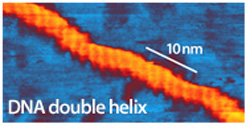 Register Now8:00-9:00am PDT
Register Now8:00-9:00am PDT4:00-5:00pm PDT
You may be a biologist new to the AFM or an AFM expert starting to study biology. When you first start out, using an AFM for biological applications can seem overwhelming. Although there are challenges for successful AFM in biology, we’ll show you it’s easier than you think!
Sample prep is a critical part of successful Bio-AFM. There are some basic principles that help insure success. However, life is complex and so are biological samples – with variations as large as the number of researchers. Thus, at the same time, you will need to be flexible – your samples may require a prep that is tweaked and tailored a bit to optimize your results. Working in liquid adds another challenge. In addition, the choice of measurement mode may not be obvious. Do I want to use tapping mode? Force curves? Contact Mode? Finally, there is a long list of commercial cantilevers available and choosing the best one can be like looking for a needle in a haystack.
The Webinar presents four case studies of typical biological samples
1. Imaging DNA in liquid – including routine helix resolution
2. Imaging living cells in liquid
3. Measuring Young’s modulus of living cells
4. Unfolding forces in Titin
In each case we will discuss sample prep, lever and measurement mode choice and follow up with data interpretation and cautionary examples of experimental artifacts. The goal of this webinar is to give you the confidence to repeat these experiments yourself and then extending them to fit your own research.
About the lecturer
Irene Revenko is one of the world’s leading experts in Bio AFM. She is a staff scientist at Asylum Research and has over 19 years of AFM experience. She initiated the first bio-classes at Asylum Research in 2002 and since then has taken many students from their first AFM measurements through cutting edge results.

